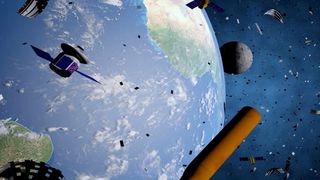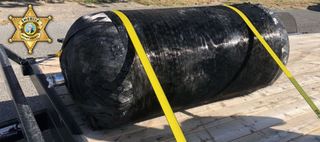What goes up must come down: Study looks at risk of orbital debris casualties

It's only a matter of time before someone is killed by falling space junk.
The toll taken by space debris so far includes an Indonesian livestock pen's fence crushed by a stray fuel tank, a house in the Ivory Coast damaged by a chunk of a first stage, and a woman in Tulsa, Oklahoma, walking in the park who felt a piece of rocket tap her on the shoulder.
The next piece of space debris that falls all the way to Earth's surface could cause very real casualties, and the odds are greater than people think, according to a new study. The research, led by Michael Byers, a political scientist at the University of British Columbia in Canada, measures the risk that a piece of space debris will fall to Earth in a populated area over the next given decade. Byers and his team calculated chances as high as one in 10 that a chunk of spacecraft big enough to injure someone or cause property damage will survive the trip through Earth's atmosphere in the next 10 years.
Given ever more frequent launches, those odds are likely to rise, said Aaron Boley, an astronomer at UBC and co-author of the study. However, falling space debris is not a risk people often think about. "The lack of a major incident has prompted people to not be so worried about it," he told Space.com. Companies and national governments that launch rockets have yet to hammer out more efficient and clear-cut ways to address issues such as liability for damage in the event of a space debris incident.
Related: Debris from SpaceX rocket launch falls on farm in central Washington
While the risk to an individual person is low, the sheer number of satellites and the orbits they tend to occupy mean that a piece of debris crashes relatively often. The issue is particularly stark when considered over time scales of a few years to a decade, the expected life of many satellites, and when factoring in spent rocket stages often left in orbit.
Think of it this way: While the risk of a car accident on a given day to a single driver is small, millions of drivers on the roads mean multiple collisions every day.
Get the Space.com Newsletter
Breaking space news, the latest updates on rocket launches, skywatching events and more!
Space junk has been a longstanding problem. Spent orbital stages will often end up in orbit, but even hundreds of miles up there is a tiny amount of atmospheric drag, which slows the orbiting object just a tiny bit each time it passes. Eventually it loses enough velocity that it starts to fall back to Earth. Even if a piece stays in orbit, it can collide with something, breaking up into smaller pieces that are themselves a hazard to satellites and space stations, and some of those pieces can be large enough to re-enter the atmosphere and hit the surface.
Related: China deploys deorbiting 'drag sail' to aid fight against space junk
Calculating the risk
To calculate the risks of space debris reaching Earth's surface, the team used two methods.
One approach analyzed satellites in orbits with perigees (the closest point to Earth) of up to 370 miles (600 kilometers): some 651 rocket bodies that fit that criterion. These rocket bodies are orbital stages abandoned during the launch process that don't immediately fall back to Earth. Each of these rocket bodies has a certain orbital inclination, which is the amount the orbit is tilted relative to the equator. The researchers combined this information with the population density under each rocket's orbit to calculate the odds that one of these 651 rocket bodies will hit someone.
The second method took the number of uncontrolled rocket body re-entries over the last 30 years and projected those numbers into the next decade.
By combining these two methods, the group created a model that predicts the chances that someone, somewhere, might get injured by a piece of falling space debris — and they came up with about a 10% chance over the next 10 years that someone would be a casualty.
These estimates are conservative, the authors say, because while some 1,500 rocket bodies made uncontrolled re-entries between 1992 and 2022, more and more rockets are being launched every year.

Taking responsibility
Besides the odds of a person or property getting hit with a falling rocket, there’s the issue of liability, and that is going to matter more to both private space operations and governments as the traffic to orbit gets heavier — it's going to be a cost of doing business.
The Outer Space Treaty (OST) signed in 1967, which is still the bedrock of space law, states that the government of whatever country launches a rocket is responsible for damages caused by said rocket, even if the launcher was a private company.
But the OST guideline has not been invoked very often. A rare example was the 1977 reentry of a Soviet satellite that spread radioactive debris after re-entering over Canada, Boley noted. In response, the Canadian government billed the Soviet Union 6 million Canadian dollars, of which the Soviets paid half, although perhaps not because of any international argument.
"There was also a sense that the Soviet Union was doing it because it was the right thing to do, and they weren't necessarily obligated," Boley said.
Moreover, when the OST and subsequent agreements were signed, there were only a small number of countries that could launch anything at all, Marlon Sorge, executive director of The Aerospace Corporation's Center for Orbital and Reentry Debris Studies (CORDS) told Space.com. Satellites and anything else that reached orbit was likely to be government-owned, or at least launching from the operating company's home nation.
That's no longer the case — a satellite from one country might fly on a rocket built by another country from a launch pad in a third nation. While liability is (in principle) with the country within whose borders the launch took place, who ultimately pays when something goes wrong has not yet been determined.
Related: Kessler Syndrome and the space debris problem
A 2020 incident points to very real concerns: A spent Chinese rocket stage damaged a house in the Ivory Coast. "The U.S. was very upset over the Long March launches," Boley said. But the situation could easily be reversed.
The United States currently launches the most payloads into space each year by a massive margin, and debris from some of these has indeed fallen on private citizens' property both in the U.S. and in other countries. Luckily, none of these incidents has caused harm to anyone on the ground.
Still, the risk is there. "How would the U.S react if one of the launches it authorized did kill someone?" Boley wonders. It's possible that if more incidents occur, even without causing injury or wrongful death, the government could suspend launches from a certain operator for a period of time, until an inquiry could be completed.
Accepting liability is one thing, but mitigating risk is another. Even if the launch-authorizing nation does take on liability for its space debris, that doesn't alter the fact that the risk from the launch can sometimes fall on other countries, Boley said, especially because many developing nations happen to be located near inclinations required for many satellites.
Sorge of The Aerospace Corporation disagreed with that assessment, noting that inclinations of communications satellites, for example, are more highly inclined to provide coverage for users. SpaceX's Starlink internet constellation, which is meant to total nearly 12,000 satellites, will orbit primarily at inclinations between 42 and 53 degrees.
Related: Space junk: Tracking & removing orbital debris

What can be done
The risks of space debris are unlikely to dampen the increasing number of launches, so risk reduction measures tend to focus on how debris falls to Earth.
One simple solution is to require launch companies to equip rocket stages with small engines to control de-orbiting and ensure this debris comes down over oceans or unpopulated areas, Jonathan McDowell, an astrophysicist at the Harvard Smithsonian Center for Astrophysics, told Space.com. Space agencies and satellite companies do this to an extent already, but having a formal requirement would make the practice more common, he said.
Sorge said many upper-stage rockets already carry a little extra fuel so the launch entity can direct the descent to more specific places. This capability is especially important because an upper stage, which is the part of a rocket most likely to end up in orbit (at least temporarily), has an engine attached that is big and dense enough that it's likely to survive re-entry.
Manufacturers are also exploring designing disposal into rocket bodies and satellites from the very beginning, including researching what materials will burn up on re-entry and which ones won't.
"When you're building you think about what you are putting in in terms of materials, and you avoid using stuff with high melting points," Sorge said. "Like maybe using a bunch of titanium bolts is not the best idea."
However, what happens on re-entry is still not an exact science, he said, because observing re-entering debris burn up requires being relatively close, often to a remote area. The Aerospace Corporation has attached recorders to some re-entering bodies to get pressure and temperature readings to try and collect more data on what happens to debris during re-entry.
Another approach is simply standardizing rules. Sorge noted that currently, there are slightly differing rules for debris mitigation depending on whether a satellite is a NASA research platform, a military payload or a communications satellite. Bringing those rules into agreement is a slow process.
Boley said there are many ways to reduce frequency of space debris incidents; it's a matter of the will to use them. "The idea is motivating best practices before there is a major incident."
The research is described in a paper published July 11 in the journal Nature Astronomy.
Follow us on Twitter @Spacedotcom and on Facebook.
Join our Space Forums to keep talking space on the latest missions, night sky and more! And if you have a news tip, correction or comment, let us know at: community@space.com.

Jesse Emspak is a freelance journalist who has contributed to several publications, including Space.com, Scientific American, New Scientist, Smithsonian.com and Undark. He focuses on physics and cool technologies but has been known to write about the odder stories of human health and science as it relates to culture. Jesse has a Master of Arts from the University of California, Berkeley School of Journalism, and a Bachelor of Arts from the University of Rochester. Jesse spent years covering finance and cut his teeth at local newspapers, working local politics and police beats. Jesse likes to stay active and holds a fourth degree black belt in Karate, which just means he now knows how much he has to learn and the importance of good teaching.
